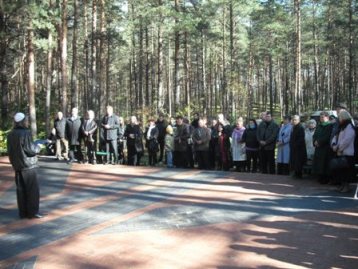by Defending History Staff
Svintsyán [Švenčionys] — Some fifty people gathered in the forest at midday today at the mass grave at Poligón, outside Švenčioneliai (Yiddish: Svintsyánke), in northeastern Lithuania, where around 8,000 Jews were murdered on 7 and 8 October 1941 after more than a week of barbaric incarceration and humiliation. The number includes nearly all the Jews of the county-seat town Švenčionys (Svintsyán) as well as the Jewish citizens of a number of towns and villages in the region, including (Yiddish names first in the following list, followed by current Lithuanian or Belarusian names): Dugelíshik (Naujasis Daugėliškis), Duksht (Dūkštas), Haydútsetshik (Adutiškis), Ignalíne (Ignalina), Koltnyán (Kaltanėnai), Kaméleshik (Kimelishki, Belarus), Labonár (Labanoras), Lingmyán (Linkmenys), Líntep (Lyntupy, Belarus), Maligán (Mielagėnai), Podbródzh (Pabradė), Saldúteshik (Saldutiškis), Salemánke (Salamianka), Stayátseshik (Stajotiškės), Svintsyánke (or Nay-Svintsyán — Švenčionėliai), and Tseykín (Ceikiniai).

Misha (Meyshke) Shapiro (at left), head of a region’s tiny remnant Jewish community, chairs the annual commemoration in the forest at a mass grave where 8,000 Jews were killed in two days in October of 1941.
 Švenčioneliai, interwar Poland’s Nowo-Święciany). Such is the custom every year on the first Sunday in October, to remember the eight thousand Jewish civilians murdered there after a gruesome ten days of imprisonment, deprivation of basic human needs, and torture, in makeshift barracks here at the site, in October 1941. The eight thousand Jews were marched (with the lame and the old transported on wagons) from their hometowns in the area to the site on September 27th. They were all shot over a two-day period on the 7th and 8th of October 1941.
Švenčioneliai, interwar Poland’s Nowo-Święciany). Such is the custom every year on the first Sunday in October, to remember the eight thousand Jewish civilians murdered there after a gruesome ten days of imprisonment, deprivation of basic human needs, and torture, in makeshift barracks here at the site, in October 1941. The eight thousand Jews were marched (with the lame and the old transported on wagons) from their hometowns in the area to the site on September 27th. They were all shot over a two-day period on the 7th and 8th of October 1941.